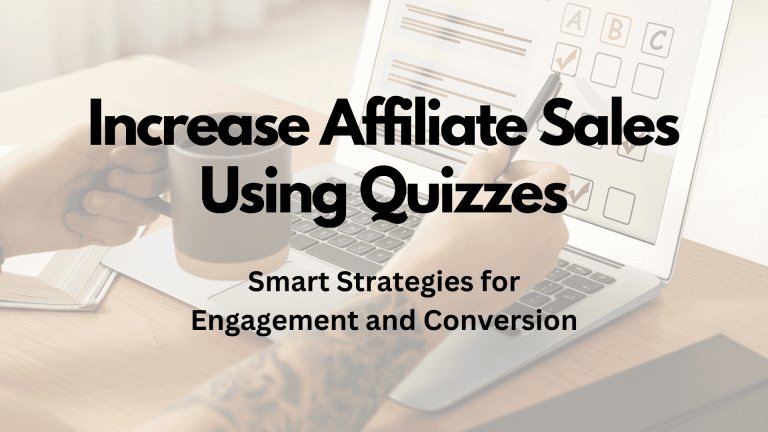
WordPress is a widely used content management system that gives you the flexibility to design and manage your own affiliate marketing website.
With its user-friendly interface, you can set up a site that aligns with your online business goals without needing extensive technical skills.
By installing WordPress and choosing the right theme and plugins from WordPress.org, you can create a professional and effective affiliate site that stands out in the digital marketplace.

To optimize your affiliate website, WordPress offers an array of customizable options.
Selecting an appropriate theme is crucial for presenting your content in an engaging way.
This sets the groundwork for your site's look and feel, which can significantly impact visitor retention and conversion rates.
Additionally, WordPress plugins enhance functionality, allowing you to integrate affiliate links, track performance, and add features that cater to your marketing strategies.
When you install WordPress, you're taking the first step to establishing a robust online platform for your affiliate marketing endeavors.
The process involves securing a domain, choosing a hosting service, and installing the WordPress software.
Once installation is complete, you'll have access to endless possibilities for tailoring your website to your specific affiliate program needs, ensuring that your content effectively reaches and resonates with your target audience.
Setting Up Your WordPress Affiliate Site

To effectively set up your WordPress affiliate site, crucial steps involve selecting a domain name, crafting a brand-centric blog name, installing WordPress, and choosing an impactful theme.
Choosing and Registering Your Domain Name
Your domain name is a central element—it's how visitors find your site.
Use a reputable service to check domain availability and register your chosen name.
Opt for a domain that is:
- Simple and memorable: Keep it short, easy to spell, and relevant to your niche.
- Descriptive: Aim for a name that reflects your affiliate content and promotes brand recognition.
Branding Tips for Selecting Your Blog's Name
Your blog's name is pivotal for branding. It should resonate with your target audience and convey your site's essence. To select an appropriate name, consider:
- Uniqueness: Stand out with a creative and unique name that's not easily confused with others.
- Relevance: Ensure the name aligns with your affiliate niche and is adaptable for future growth.
Installing WordPress
Installing WordPress can be streamlined with your hosting provider's tools such as Softaculous, QuickInstall, or Fantastico found within cPanel.
- Log into your hosting account's control panel.
- Locate the WordPress installer tool.
- Follow the prompts to complete the installation process, which includes setting up a MySQL database and configuring necessary settings.
Manual installation via FTP is an option for those who prefer more control.
Choosing Your Blog's Theme
Selecting the right WordPress theme is about matching your affiliate site's objectives with a functional and aesthetically pleasing design. When choosing your theme:
- Explore themes that are optimized for performance and mobile responsiveness.
- Look for themes with a customizer that allows for easy adjustments to the layout, fonts, and colors to maintain brand consistency across your site.
Remember, a well-chosen theme enhances your site’s professionalism and can contribute to better conversion rates.
Essential Pages and Features
When creating a WordPress affiliate site, several specific pages and features are fundamental to its functionality and legal compliance.
Creating Mandatory Pages for Your Website
Your affiliate website needs to comprise a core set of pages that visitors expect and that fulfil legal requirements.
These pages are essential not just for user experience but also for establishing trust and transparency with your audience.
- Homepage: This is your site's front door. Ensure it is inviting, clearly presents your brand, and directs visitors to important sections of your site.
- About Page: Here you describe your website’s purpose. This humanizes your site and often includes your affiliate disclosure, informing visitors about your monetization methods.
- Contact Page: Allows visitors to reach out to you. Feature a simple form or your contact details.
- Privacy Policy: This page outlines how you handle user data. It's not just best practice; in many cases, it's legally required. Templates for privacy policies are available for free download from various online sources.
- Terms of Service: Details the rules and guidelines for using your site. While templates are available, tailor this document to your site's specifics.
- Affiliate Disclosure: Clearly state your relationship with the products or services you're promoting to comply with legal requirements. Keep the language straightforward and clear.
Your website will require an intuitive layout and navigation, ensuring that these pages are easily accessible.
Using the WordPress CMS, you can upload custom HTML for a more unique look or rely on themes that have these pages pre-designed.
Your choice of theme and customization tools are key to creating not just a functional but an enticing affiliate website where these essential pages are integrated seamlessly.
Joining Affiliate Programs

When joining affiliate programs, first identify your niche to align with products or services that resonate with your audience.
Research different affiliate programs that offer items your audience may find valuable. Look for programs with competitive commission rates, ensuring your efforts are appropriately rewarded.
Selecting a Program:
- Prioritize affiliate programs with a strong reputation for quality.
- Consider commission rates: Higher percentages can lead to more income.
- Check payout schedules and methods to ensure they meet your needs.
Applying to Programs:
- Fill out applications with accurate details about your e-commerce store or presence.
- Demonstrate your ability to generate traffic and sales.
- Be prepared to explain how you'll promote their products.
Remember:
- Some programs offer higher commissions for increased sales volume.
- Discounts and specials can be leveraged to boost sales.
- Digital products often have higher commission rates due to lower overhead costs.
After Approval:
- Utilize provided analytics tools to track your success.
- Continuously optimize your approach based on performance data.
- A successful affiliate program will help you generate steady commissions.
Developing High-Quality Content

When building content for your affiliate site, focus on enriching the user experience by offering insightful and detailed information.
Start with understanding your audience's interests and tailor your content to meet their needs.
Content Marketing: Your approach should be strategic.
Craft articles, guides, and posts that not only highlight products but also provide educational value.
This enhances trust and authority, paving the way for increased traffic to your site.
WordPress Plugins: Utilize available tools to aid content creation.
Plugins such as Yoast SEO can help optimize your content for search engines, while others allow easy insertion of affiliate links.
Quality Over Quantity:
Prioritize well-researched, accurate content that solves problems or answers questions.
Whether it's a daily deals website or a product review website, your content should always be accurate and trustworthy.
Formatting Is Key:
Make use of headings, bulleted lists, and tables to break up text and ensure your pages are easy to navigate. This not only pleases your readers but also search engines that favor well-structured content.
Prompt readers to interact with your content through comments or social media shares.
Engaged users are more likely to return, recommend your site, and convert on your affiliate offers.
Promoting Your Affiliate Site

When promoting your affiliate site, focusing on increasing visibility and driving quality traffic is essential.
Marketing is at the heart of any successful affiliate strategy.
Begin by identifying your audience and tailoring your content for maximum engagement to boost sales.
Using Google ads can quickly elevate your site's presence, placing your affiliate products in front of potential buyers.
Consider bidding on relevant keywords to appear in search results, thus improving your chances of generating sales and commission.
Employ an email marketing platform to keep in touch with your subscribers.
Send them regular updates on new products and exclusive deals.
Personalized email campaigns can significantly improve brand recognition and facilitate repeat purchases.
Integrate into an established affiliate marketing program.
These programs offer tools for tracking referrals, giving you insightful data to tweak your promotions for better performance.
Don't overlook the importance of content marketing.
Create informative articles and reviews about your affiliate products.
High-quality content can improve your site's search engine ranking and attract organic traffic, ultimately increasing your revenue.
To ensure your marketing efforts are effective, always analyze the performance of your campaigns.
Use analytics tools to understand your audience's behavior and preferences.
This data will help you make informed decisions about where to focus your efforts.
Tracking and Enhancing Performance

To ensure the success of your affiliate site, it's essential to monitor your traffic and sales closely and make necessary optimizations for search engines.
Using Analytics to Monitor Traffic and Sales
Google Analytics plays a crucial role in tracking the performance of your affiliate site.
By integrating Google Analytics, you gain insights into user behavior and traffic sources.
To start, set up goals and eCommerce tracking to measure key actions such as form submissions or product purchases.
- Traffic Sources: Identify which channels (organic, direct, referral, social, or paid) are driving visitors.
- User Engagement: Measure bounce rate, average session duration, and pages per session.
- Sales Data: Monitor transactions and revenue to determine the effectiveness of your affiliate marketing program.
- AffiliateWP Integration: For those using AffiliateWP, link it with Google Analytics to track referral rates and affiliate performance.
To enhance tracking:
- Create a Google Analytics account and add your site.
- Set up tracking codes on your affiliate site.
- Utilize UTM parameters to track the performance of specific campaigns.
- Review reports regularly to understand trends in traffic and sales.
Optimizing for Search Engines
To improve your site's visibility in search engine results, SEO optimization is key. This encompasses both on-page and off-page strategies designed to boost your online presence.
- Keyword Research: Identify high-traffic keywords relevant to your niche.
- Content Optimization: Incorporate targeted keywords into your site's content, including titles, headings, and meta descriptions.
- Site Performance: Ensure your site loads quickly and is mobile-friendly.
- Backlinks: Acquire quality backlinks from reputable websites within your industry.
Actionable steps to optimize your site for search engines:
- Use tools like Google Keyword Planner to research keywords.
- Employ SEO plugins, such as RankMath SEO, to guide on-page optimization.
- Analyze site speed with tools like Google PageSpeed Insights and make necessary adjustments.
- Build backlinks through guest blogging, partnerships, and high-quality content marketing.
- RankMath SEO: Helps optimize your site for search engines.
- Akismet: Defends against spam comments and trackback spam.
- WPForms: Lets you create an affiliate registration form.
- Social Media Integration: Utilize platforms like Twitter, Facebook, and Instagram to amplify your reach.
- Regular engagement on these channels can drive traffic back to your site and enhance your online visibility.
- Update regularly: Keep WordPress, themes, and plugins up to date.
- Backup frequently: Ensure you have scheduled backups.
- Use strong passwords: Opt for unique and complex passwords.
- Install security plugins: Consider adding extra layers of security.
- Select SEO-friendly themes: Themes optimized for search engines are advantageous.
- Use SEO plugins: Plugins like RankMath SEO can guide your content creation.
- Engaging content: Create posts that resonate with your audience.
- Consistency: Update your site with fresh content regularly.
Share Your Journey, Learn More, and Thrive
I would love to hear about your experiences, challenges, and successes in the realm of affiliate marketing.
Share your thoughts, questions, or stories in the comments section below.
Let's build a community of aspiring and experienced affiliate marketers, supporting one another on this exciting journey.
For more valuable insights, tips, and guidance on affiliate marketing, subscribe to our newsletter.
Stay updated with the latest trends, tools, and strategies that can empower you in your pursuit of affiliate marketing success.






